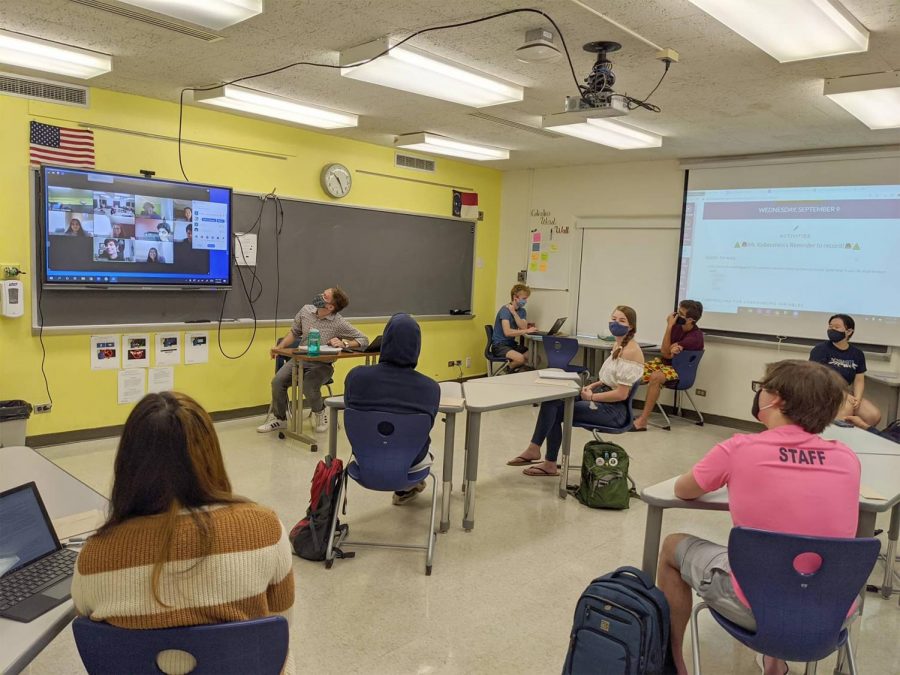FUSD’s Failed Reopening Negotiations Has Failed Students
A photo by Matt Torman depicting how a hybrid classroom could be set up (https://blog.zoom.us/high-school-teachers-share-best-practices-for-successful-hybrid-learning/ncssm-ap-stats/).
On March 31st, the Fremont Unified School District superintendent released a letter announcing that FUSD would not be looking into a possible hybrid learning model for the rest of the school year after they walked away from negotiations with FUDTA (Fremont Unified District Teachers Union). Parents frustrated with this decision have heavily protested online and have even reached out to lawyers to engage in possible lawsuits. A scroll down any Facebook post by FUSD that is even remotely related to the pandemic will reveal dozens of angry comments about the situation. It’s easy to dismiss this activity as the work of overdramatic parents, but there are legitimate reasons to be concerned about the FUSD decision to walk away from negotiations.
Distance learning has put immense stress on many people, especially parents who have essential jobs and cannot afford to babysit kids, and as a result, many hoped that a plan to reopen schools would go through. In Alameda County, 14 out of 18 school districts have settled on reopening plans to some degree (many being prompted by an additional $9-10 million in funding from the state available to open schools), and many had the expectation that Fremont would follow suit. FUSD’s decision has been to the detriment and disappointment of many students and parents in the district, but with only a few weeks left in the school year and weeks of precious negotiation time having gone down the drain, chances of a concrete plan being settled on are slim.
People in full support of the district’s decision to eliminate the possibility of hybrid learning tend to forget that it encompasses all grade levels, including preschool to 6th graders, who require more stimulation in their learning environments. A majority of high school students may get by with limited learning loss, but school for these younger children is an environment where they can develop basic social skills. Social development at this age is relatively important, and in-person school provides a perfect ecosystem for that development.
In an online setting, it’s almost impossible to replicate this. Teachers have gone to great lengths to try and connect with their students, and even then, tech issues and student unwillingness greatly hinder this effort. Not to mention the fact that computers provide a gateway into an infinite number of distractions, it’s safe to say that online learning is not ideal for younger students. Secondary students may not feel the effects of the decision to not pursue optional hybrid learning, but elementary students certainly will.
Distance learning has also shown to have the most profound impact on kids from lower income families, and has further increased the gap between excelling students and struggling ones. Parents with essential jobs that can’t be done from home may find it difficult to provide the support students usually get from schools. In this particular school district, where many students’ parents have white collar jobs, polls may skew towards a majority of parents and students preferring to continue distance learning. This however, doesn’t negate the fact that there is a very distinct minority with very real needs that should have options open for them.
While the district made promises to expand on “learning hubs” in order to accommodate such students, such hubs are barely even a solution for those that require in-person teaching to fully learn. Learning hubs are essentially classrooms set aside for students to have a quiet place to safely attend their classes in cases where they’re unable to stay at home. The catch is, learning hubs don’t actually offer in-person instruction. They also can’t remedy the fact that these students will still be in an online environment and thus unable to reach out for help the same way they could in person. On top of the fact that students will have to commute to school everyday just for Zoom classes, it’s likely that they will prefer to take classes at home even though it could be worse for overall learning in the long run.
It’s definitely not impossible to set up hybrid learning for these students, especially elementary school students that don’t have multiple teachers per student. After all, a majority of school districts in Alameda County have already done so to some degree in order to open up schools to students who would like to learn in-person. Using these existing plans as frameworks for Fremont’s own return to optional in-person learning could have been a legitimate solution before negotiations were cancelled. With limited time until the school year ends, and radio silence from the district about this topic, however, it’s unlikely we will see discussions about reopening until preparations for next year’s return begin.
FUSD’s refusal to continue negotiations for elementary and secondary schools has not just been to the disappointment of parents and students, but also to representatives of FUDTA who has also released a statement regarding the district’s decision.







